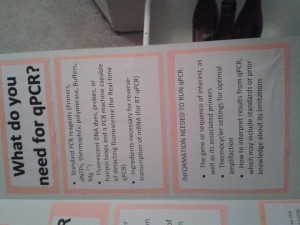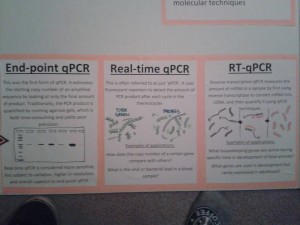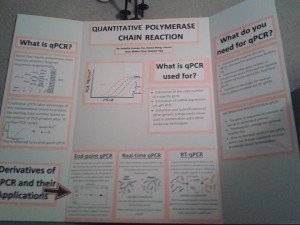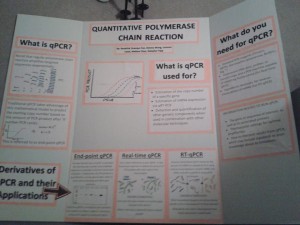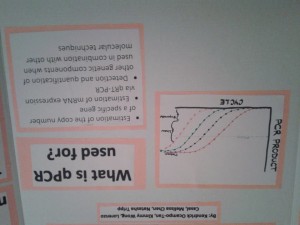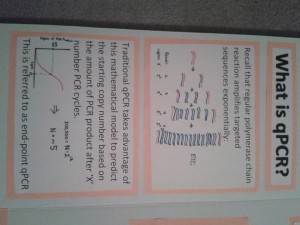TECHNIQUES SPEED-DATING: Quantitative Polymerase Chain Reaction
Names and contributions of group members:
Kenrick Ocampo-Tan (Editing, answering questions)
Natasha Tripp (added a few bullet points, edited references)
Lorenzo Luis Casal (editing, answering questions)
Melissa Chen (Editing, condensing information, poster design)
Kimmy Wong (Organized documents, added several bullet points, editing info)
Technique chosen: Quantitative PCR and its derivatives
What does this technique ‘do’?
- Quantitative polymerase chain reaction estimates the starting copy number of a DNA/mRNA segment
- Can be estimated using the final product concentration after ‘X’ cycles (end-point qPCR) or by detecting the amount of products generated after each cycle (real-time qPCR)1
What applications are this technique employed for?
- Estimating DNA copy number or detecting DNA from a sample2
- Gene expression analysis by quantifying mRNA (RT-qPCR)2,4
What questions (give a couple of examples) relating to gene regulation and/or development can be addressed using this technique?
- How does the copy number of a certain gene compare with others? (qPCR)
- What housekeeping genes are active during specific time in development of fetal animals? (RT-qPCR)
- What genes are used in development but rarely expressed in adulthood? (RT-qPCR)
- Is there differential expression of genes under different stress conditions? (RT-qPCR)
What critical reagents are required to use this technique?
- Both qPCR and RT-qPCR require standard PCR reagents (Forward and reverse primers, dNTPs, thermophilic polymerase, Mg2+, appropriate buffers)
- qPCR also requires DNA template and either a dye or probe that fluoresces when hydrolyzed or hybridized4
- RT-qPCR requires reverse-transcriptase (and other standard RT-PCR reagents) in addition to all of the above
- real-time PCR requires a PCR machine capable of detecting the amount of product after each cycle
What critical information is required to be able to employ this technique?
- Sequence data to be able to create primers
- Proper annealing temperature for reaction specificity
References:
- Heid, Christian A., Junco Stevens, Kenneth J. Livak, and P. Mickey Williams. “Real time quantitative PCR.” Genome research10 (1996): 986-994. Web. 01 Feb 2015.
- Karlen, Yann, Alan McNair, Sébastien Perseguers, Christian Mazza, and Nicolas Mermod. “Statistical significance of quantitative PCR.” BMC bioinformatics1 (2007): 131. Web. 01 Feb 2015.
- Lederman, Lynne. “QPCR.” BioTechniques4 (2009): 817-19. Web. 01 Feb 2015.
- VanGuilder, Heather, Kent Vrana, and Willard Freeman. “Twenty-five Years Of Quantitative PCR For Gene Expression Analysis.” Biotechniques 5 (2008): 619-26. Web. 01 Feb 2015.

